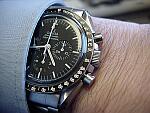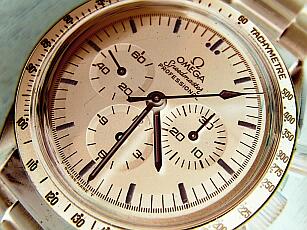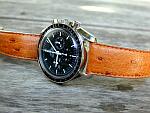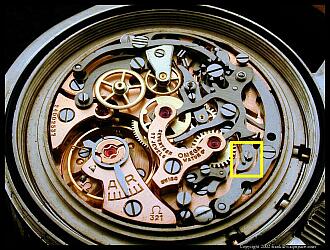
How the brake spring
should be positioned

The Speedy Broad Arrow - perhaps the most beautiful Speedy ever

The glow of a new Speedy
Photo by Dan Ravenna
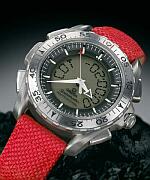
The 'Mars' watch -
the new X33
|
ONE INTERESTING thing occurred whilst I had the dustcover off and was gazing at the movement. I was comparing it to Frank N's photograph when I noticed something not quite right. (Click on the photo at left to enlarge it, and check out the yellow box.) In Frank's magnificent photo, the spring bears against the left-hand side of the screw as we look at it, moving the brake close to the centre chrono wheel. In my watch, the spring is on the other side of the screw, and flops around so that the brake doesn't come into play. And yet everything seemed to be functioning normally. Was this a new Omega service instruction? Or was it, horror of horrors, some incorrect assembly? I wondered how I could tactfully point this out to John—or rather to Grant, his assistant (also a qualified watchmaker), who had actually carried out the job. I went into the shop somewhat tentatively.
"Hallo Les," said John cordially. Then he continued before I had a chance to speak, "Sorry, but I still haven't had a chance to get onto that Oris."
"Actually, I haven't come about that, John......er, I just happened to notice something strange the other day..." I went on to explain my 'observation', carefully explaining I was sure there was a good reason for it, but...
John must have been in a playful mood (he was going on holiday next day), for he shouted into the workshop, "Grant, Les has got a complaint about that Omega you serviced for him."
Oh great, I thought, now I'm going to be in the you-know-what with Grant.
"It's not really a complaint," I demurred, smiling so hard my cheeks hurt, "it's more of an observation..."
Grant came out of the workshop, wiping his hands on his apron and obviously ruffled by having his workmanship questioned. The back came off the watch like a spinning top and the loupe attached to his glasses was snapped into place with considerable force. He turned the watch this way and that, looking at the offending spring. "Didn't go out like that" he muttered, taking my Speedy with him back into the workshop. A few minutes later he was back out again.
"It's the screwhead," he said, "it's too short, so the spring slips over it when you stop the chrono. I thought there were a few screws in there that didn't look original."
"Probably been replaced because they were rusty," said John, referring back to the water-damage theory.
"But why does the sweep second hand not wander about if the brake's not working?" I enquired.
"There's a friction spring under the wheel," said Grant. "The brake's just insurance."
So there we are. Nothing too serious, just a replacement screw needed. And as soon as I can prise the Speedy off my wrist long enough to leave it with Grant, I'll get it done. I just don't want to be parted from it, it's that sort of watch. It's a classic design with a heritage, it's useful and dependable, and it's comfortable. It'll run for two days without a wind. It feels good to give it its daily "feed". And I now know why thousands of Speedy owners feel the same way.
But perhaps we should let the first man who wore a Speedy on the moon, Buzz Aldrin, have the last word about its qualities:
"...It was a lousy watch to have on the surface. It just didn't give good numbers as far as a stopwatch type thing. To have gone to all that expense and then to have crews out on the surface with just an ordinary watch, in retrospect, is a mistaken priority somewhere." (NASA debrief)
Well, there's something you won't find in Omega's advertising! But Buzz is right, of course. For critical timing under difficult conditions, a digital watch would be far easier to use. That's why the Omega X-33, the Casio G-shock and the Timex Ironman are used by NASA for EVA's today. But in the late 1960s, were there any suitable digital watches? Probably not. It doesn't matter, anyway. The Speedy Moonwatch is part of history. And by owning one, so am I.
Specifications
Model: 1968 Omega Speedmaster Professional 145.012 '1st Generation'
Movement: Cal. 321 signed with Omega logo; 17j manual wind 3-register column wheel chronograph; monometal screwed balance; Breguet overcoil hairspring; 18,000 vib/h (2.5Hz); Incabloc shock protection; anti-magnetic dust cap.
Case: all stainless steel; asymmetric due to crown & pusher guards; screw back (signed); 40mm Ø (43mm inc. crown); 13mm overall height inc. crystal; 20mm between lugs; 47.5mm lug-to-lug; crown 6.5mm Ø (signed); pushers 5mm Ø; tachymetre bezel; weight 105g inc. steel bracelet.
Bracelet: Type 1171 all stainless steel; 3-link design with solid outer and folded inner links; deployant clasp (no flip lock or pushers); signed with Omega logo on outside of clasp and inside of deployant; tapers from 20mm to 16mm at clasp; clasp is 17mm wide.
Crystal: Hesalite (acrylic); signed at underside centre.
Footnote
It would appear that despite the general lack of interest in Space Shuttle flights by the general population, who seem to treat these now as nothing out of the ordinary, there are still those for whom the experience of being weightless in space is something for which they'd pay dearly. According to a recent newspaper report, a British company called 'Starchaser' wants to build the world's first commercial spaceport at Woomera, South Australia. (Woomera is the place where the British experimented with the 'Blue Streak' rocket, and various other nations have also launched, or tried to launch, their hardware.) If you have a spare AUD$500,000 (US$250,000), you will be able to enjoy a 23-minute flight including 8 minutes of 'zero gravity'. According to the founder of the company, Steve Bennett, "You get a full body suit like the astronauts wear, as well as training and a space wristwatch—you have to give the suit back but you can keep the watch."
At that price one would hope it's a Speedmaster and not a Timex Ironman.

* * *
Also in the news recently is the announcement by singer Michael Jackson that he intends to fly into outer space so that he can perform his 'moonwalk' on the actual surface of the moon. Sounds like he's already been handling some of that 'whitish-grey powdery stuff'. At this rate he won't even need a rocket to get there.
* * *
It's just occurred to me. John's never intended to fix my wife's Oris all along—he just keeps it there as bait to get me in.
Sources of information and Useful Links
'A Time Capsule - Omega Speedmaster' The Story of the First Watch in Outer Space by Kesaharu Imai (World Photo Press)
'A Man on the Moon' by Andrew Chaikin (Viking Press 1994)
Various articles concerning the Gemini and Apollo missions published on the web by NASA
Chuck Maddox's Homepage
Robert-Jan Broer's Homepage (Omega-addict)
|
